The lathe is defined as the machine tool, which is used for different machining operations such as turning, facing, threading, etc.
Lathe Machine and Types
A lathe machine is a machine that holds the workpiece on a chuck and tool on a toolpost, the lathe machine rotates the workpiece about an axis to perform different operations such as turning, facing, chamfering, thread cutting, knurling, drilling, and more with tools that are applied to the workpiece to design an object with symmetry about that axis.
The main function of a lathe is to remove the metal from a workpiece to give a required size and shape. In a lathe machine, the tool is held, and a workpiece is rotating about an axis rotation to perform various operations with different tools.
The lathe machine is primarily used to produce cylindrical surfaces and plane surfaces at a right angle to the axis of rotation. It can also produce tapers and bellows etc. Most suitable lathes can also be still used to produce most solids of revolutions, plane surfaces & screw threads, etc.
Read also: What are the different types of DNC machines?
Parts of Lathe Machine
The following are the main parts of lathe machine:
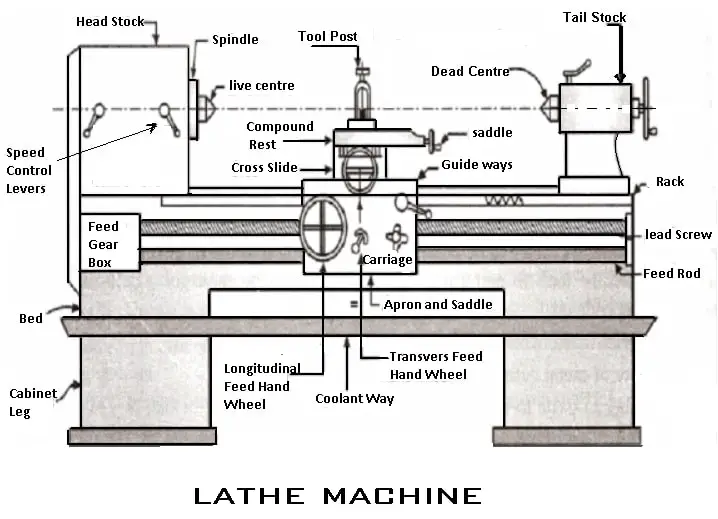
- Bed
- headstock
- Carriage
- Feed mechanism
- Tailstock
- Screw or thread cutting mechanism
- Feed rod
- Lead screw
#1 Bed
The lathe bed is the base of the machine, which is a solid structure. It should be provided strictly under heavy pressure. On top of the bed, has the V-type of guideways include the angle of 90°.
There are two guideways provided, inner ways and outer ways, which are accurately machined to make them parallel to the axis. The lathe should take up the various vibrations, which are causing due to different types of force. The guideways provide sliding surfaces to the carriage and the tailstock.
The lathe bed must resist stresses due to the results of two important forces,
- The downward cutting force on the tool
- The force tends to move the tool away from the workpiece in a horizontal direction.
#2 Headstock
- H1: Geared headstock housing,
- H2: Intermediate gears lever,
- H3: High Low gear lever,
- H4: Camlock spindle,
- H5: Tumbler gears – forward/reverse and engage/disengage,
- H6: Quick change gearbox with 4 selectors (3 levers),
- H7: Lead screw,
- H8: Feed screw,
- H9: Forward reverse switch,
- H10: Change gear cover
It is located on the left-hand side of the lathe bed. It has a hollow spindle and different types of mechanisms for driving and changing the speed of the spindle.
In this case, the speed increases when the belt shifts from larger to smaller diameter pulleys. The spindle is made up of nickel, chrome steel, and carbon steel. The front end of the spindle hole is taper for holding the centers perfectly.
The speed changing is based on the following conditions,
- The type of material to be cut
- Hard and tough materials like cast iron – slow speed
- Soft materials like aluminum, brass – high speed.
- Type of cutting tool material
- For high – speed hard tools made of tungsten carbide is used.
- For slow – speed medium hardness tool is used.
- The type of finish-finishing cut-small depth-high speed
- Rough cut – high depth – low speed.
- The diameter of the workpiece
- For large diameter workpiece – low speed
- For smaller diameter workpiece – high speed
- Type of operation
- For turning, boring, drilling – high speed
- For thread cutting, tapping, reaming – low speed
#3 Tailstock
The tailstock is located on the right-hand side of the lathe bed. The tailstock supports the other end of the workpiece when it is machining between two centers.
- T1: A feed screw
- T2: Reduction gearbox (optional)
- T3: Body
- T4: Adjustable base
- T5: Spindle
- T6: Locking Lever
It holds the tool rigidly and perfectly for performing operations such as drilling, reaming, tapping, and boring. It can move along the guideways and can clamp in any position on the bed.
The tailstock is consist of the dead centre, spindle, adjusting screw, hand wheel, etc. The spindle can move forward and backward of the body called barrel by means of a handwheel. The keyway is provided on the inside surface of the barrel to hold the dead centre.
Read also: Cutting speed, Feed, Depth of cut, Machining time in lathe machine
#4 Carriage
The carriage is one of the most important parts of the lathe tool and it will serve as a supporting, moving, and controlling part of the cutting tool.
4.1 Saddle
It is ‘H’ shaped. The saddle fits over the bed and slides along the guideways by carrying the cross slide and tool post. It can lock in any position in its movement.
4.2 Cross Slide
It is an attachment to the saddle and to the compound rest. The cross slide move by the turning handwheel. Transverse movement is obtained when the nut mounted on the feed screw is engaged with the binder screw of the cross slide.
When a taper turning attachment is used the binder screw is open to disconnect the cross slide from the crossfeed screw and the cross slide is attached to the guide block. Cross slide can move automatically when the pinion is keyed to the crossfeed screw is in mesh with the apron gearing.
4.3 Compound rest
It is a circular base, graduated in degrees and it is used to obtain angular cuts and tapers of the variable cross-section. It consists of a compound slide handwheel, compound slide feed screw, compound slide nut. The compound slide handwheel is mainly used in taper turning operations to give the feed.
4.4 Toolpost
The tool post is placed above the compound rest, and it holds the tool firmly. There are different types of tool post,
- Single screw tool post
- Four-way tool post
- Eight-way tool post
#5 Feed Mechanism
The amount of tools relative to the workpiece is called ‘Feed.’
- A lathe tool has 3 types of feed
- Longitudinal feed: Here the tool moves parallel to the lathe axis. It is affected by means of the carriage movement.
- Crossfeed: Here the tool moves at right angles to the lathe axis.
- Angular feed: By adjusting the compound slide and swivelling it to the required angle to the lathe axis.
Cross and longitudinal feeds are both hand and power operated, but angular is only hand operated.
#6 Screw or Thread Cutting Mechanism
The lathe is important to the machine tool, which is used to cut the required type of threads on a given work. The rotation of the screw is used to move the tool along the workpiece to produce the screw threads. The half-nut mechanism is used in the lathe.
#7 Feed Rod
It is a long shaft having a keyway extending from the feed box across and in front of the bed. The power is transmitted from the lathe spindle to the apron gears through the feed rod.
The feed rod is mainly used to move the carriage or cross slide for the operations such as turning, boring, facing, and all other considering the thread cutting operation.
#8 Leadscrew
It is a long threaded shaft used for only thread cutting operations. The lead screw is in an arranged position in all operations from the gearbox. It may also be used to give the motion for turning, boring, etc., in the lathes, which are equipped with a feed rod.
Read also: 14 Different Types of Lathe Cutting Tools
Types of Lathe Machines
Following are the seven different types of lathe machine:
- Speed Lathe Machine
- Engine Lathe Machine
- Bench Lathe Machine
- Toolroom Lathe Machine
- Capstan and Turret Lathe Machine
- Special-purpose lathe machines
- Automatic Lathe Machine
- CNC lathe machine
#1 Speed Lathe Machine
These types of lathe machines are simple in construction. It has a bed, headstock, tailstock, and tool post mounted on the adjustable slide. There is no feed box lead screw or carriage.
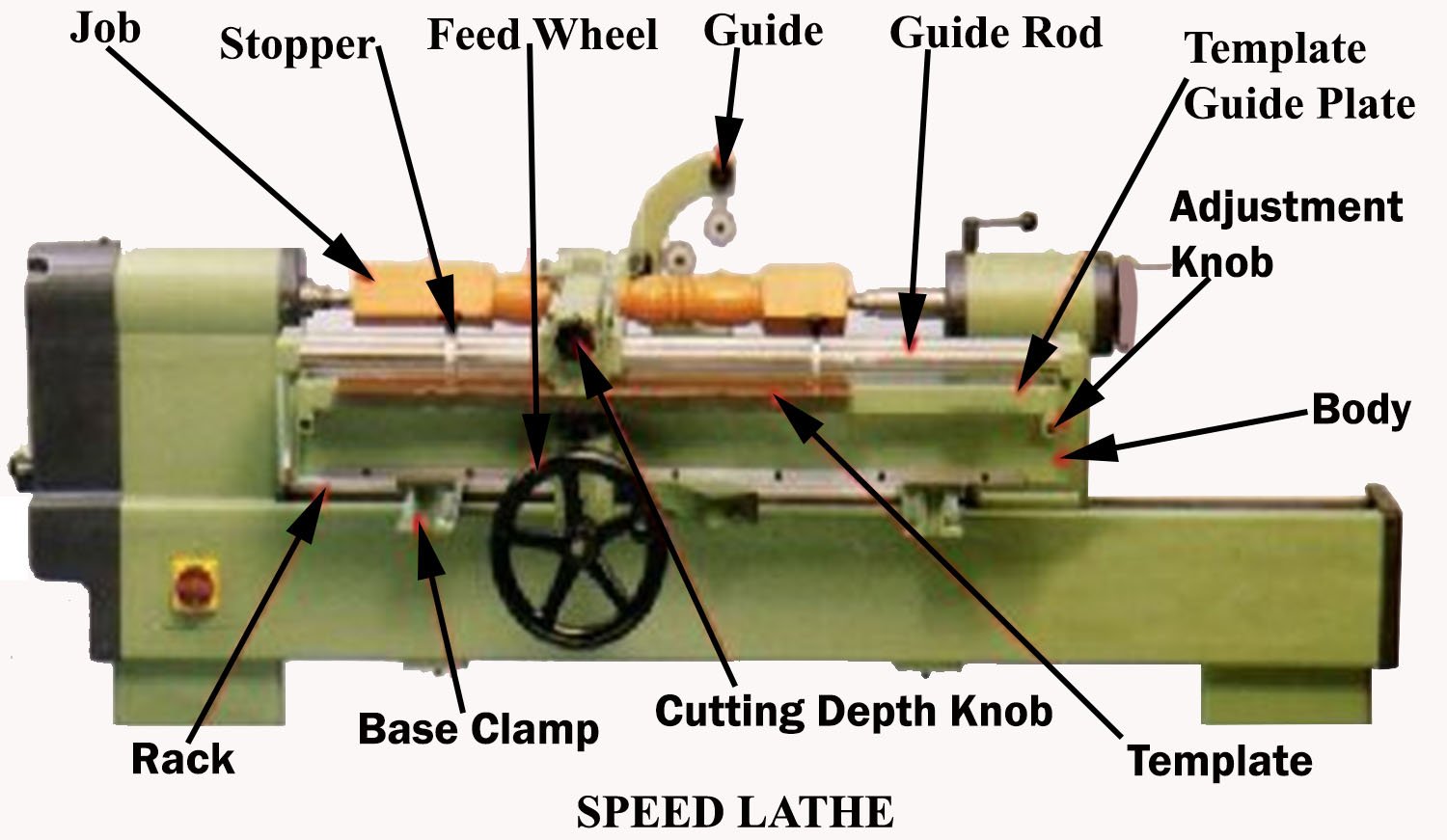
The tool is mounted on the adjustable slide and is fed into the work purely by hand control. This characteristic of the lathe machines has a speed range from 1200 to 3600 rpm. The headstock construction is very simple and has only 2 or 3 spindle speeds available.
Speed lathe machine has less depth of cut. Light force and high speed made this to use this part woodworking, spinning, centering, and polishing. The name speed lathe has been given because of the very high speed of the headstock spindle.
#2 Engine Lathe Machine
Engine lathe is the most widely used lathe machine. These machines are driven by the gear mechanism or pulley mechanism. The name engine lathe is given because of the earlier lathe were driven by steam engines.
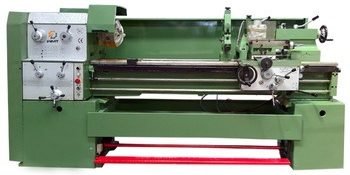
Engine lathe machine has all the parts similar to that of speed lathe. Such as bed, headstock, tailstock, etc. The headstock of an engine lathe is rigid in construction and has got an additional mechanism to get multiple spindle speeds.
Unlike the speed lathe, the engine lathe can feed the cutting tool both in the cross and longitudinal direction with reference to the lathe axis with the help of a carriage feed and leadscrew. These types of lathe machines are still used in workshops and many industries. It has three types Belt-driven, Motor-driven, and Gearhead type.
2.1 Belt Drive Lathe Machine
A lathe that receives its power from an overhead line shaft is a belt-driven lathe and is equipped with a speed cone and one or more back gears to get a wide range of spindle speeds.
2.2 Motor-Driven Lathe Machine
A lathe that receives its power from an individual motor integral with the machine is called a motor-driven lathe.
2.3 Geared-head Lathe Machine
A geared-head lathe gets its power from a constant speed motor, and all-speed changes are obtained by shifting various gears located in the headstock. It has no cone pulley.
#3 Bench lathe
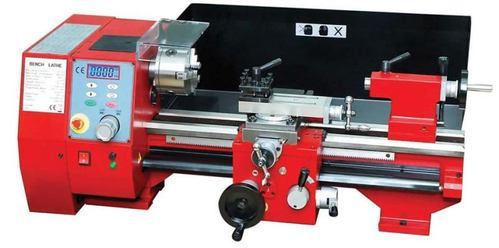
These types of lathe machines are small in size and are used for very small precision work. Bench lathe machines are mounted on the bench. It has all the similar parts of the engine lathe and speed lathe. Bench lathe machine performs almost all the operations of the engine lathe and speed lathe. Its only difference is in size.
Read Also: Understand Different Types of Chips In Metal Cutting [Complete Guide]
#4 Toolroom Lathe Machine
Toolroom lathe machine is the same as that of engine lathe but provides a wide range of speed. The spindle speed range is from very low to quite high speed up to 2500rpm.
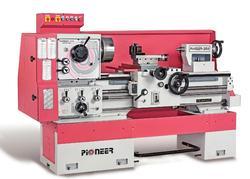
This is equipped beside the other thing, with a chuck, taper turning attachment, draw in collect attachment, steady and follower rest, pump for coolant, etc. Toolroom Lathe is costlier as compared to the engine lathe. It is mainly using in grindings, working on the tool, dies gauges, and in machining work where is accuracy is needed.
5. Capstan Lathe and Turret Lathe
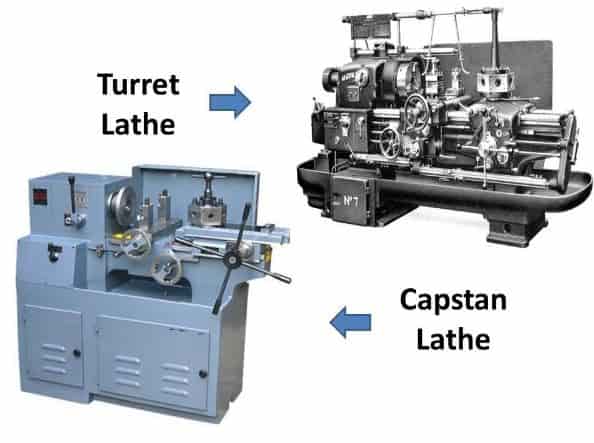
These types of lathe machines are used in production work. These lathe machines are the development of the engine lathe. These machines are provided with hexagonal turret heads instead of tailstock. It also consists of three tool posts.
In these types of lathe machines, multiple tools may be fitted and fed into the work in the proper sequence. The main advantage is that different operations and parts can produce in a very less amount of time. And also without changing the tool the quantity and quality are high.
Capstan and turret lathe requires more floor space than other lathe machines. Capstan and turret lathe is used for only large jobs.
Read the full article on Capstan and Turret lathe
6. Special Purpose Lathe Machines
As the name implies these types of lathe machines are used for special purposes and for production work. In this lathe, special operations are performed such as drilling, grinding, reaming, boring, etc.
The special-purpose lathe machines are:
- Wheel lathe machine
- Gap bed lathe machine
- T-lathe machine
- Duplicating lathe machine
- Missile lathe machine
1. Wheel Lathe Machine
The wheel lathe is made for finishing the journals and turning the thread on the railroad, automobile cars, and locomotive wheels.
2. Gap Bed Lathe
The gap bed lathe, in which a section of the bed adjacent to the headstock is removable, is used to swing extra large diameter pieces.
3. T-Lathe
The “T -lathe” is used for machining rotors for jet engines. The axis of the lathe bed is at right angles to the axis of the headstock spindle in the form of a T.
4. Duplicating Lathe
The duplicating lathe machine is one of the duplicating the shape of a flat or round template onto the workpiece. Mechanical, pneumatic, and hydraulic devices are all used to coordinate the movement of the tool to reproduce accurately the shape of the template.
5. Missile Lathe Machine
The missile lathe machine which has a very large swing for accommodating long missile components of very large diameter is the most modern and latest in lathe design.
7. Automatic Lathe
In these types of lathe machines, all the work is done automatically. These are the high-speed heavy-duty, production lathes. In these types of lathe machines, once the tool is set, it performs all the operations automatically to finish the job.
Here the change of tools and feed is automatic. The single operator can control 5 to 6 automatic lathes at a time.
Lathe machine performs different operations such as turning, facing, taper turning, knurling, grooving, parting off, electric turning, thread cutting, reaming, etc. Let it take one by one as follows.
8. CNC Lathe Machine
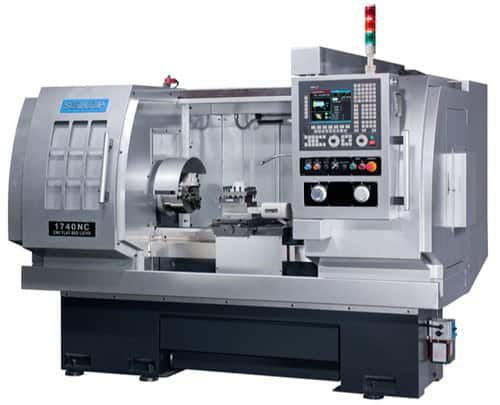
These types of lathe machines are operated with a precise set of design instructions. A CNC (computer numerical control) lathe is a machine tool that rotates the workpiece around the main spindle, while a cutting tool cuts the workpiece into a desired shape and size.
A simple CNC lathe operates on two axes with the cutting tool in a fixed position on an 8 to 24 station turret. CNC lathe ensures consistent product quality and does not require highly skilled operators to operate the machine. On the other hand, CNC machines are more expensive than manually operated machines.
Read Also: What is Twist Drill? Parts, Types, and Nomenclature [Full Guide]
Lathe Machine Operations
The lathe machine operations are classified into three main categories.
Lathe machine operations done either by holding the workpiece between centres or by a chuck are:
- Turning
- Plain or Straight Turning
- Rough Turning
- Shoulder Turning
- Taper Turning
- Eccentric Turning
- Facing
- Chamfering
- Knurling
- Thread cutting
- Filing
- Polishing
- Grooving
- Spinning
- Spring Winding
- Forming
Lathe machine operations performed by holding the work by a chuck or a faceplate or an angle plate:
- Drilling
- Reaming
- Boring
- Counterboring
- Taper boring
- Tapping
- Undercutting
- Internal thread cutting
- Parting-off
The operation performed by using special attachments:
- Grinding
- Milling
Read full article here: 22 Different Types of Lathe Machine Operations
Lathe Machine Accessories
The lathe machine accessories are used either for holding and supporting the workpiece or for holding the tool. The important lathe accessories are
- Centres
- Chucks
- Collets
- Angle Plates
- Face Plates
- Mandrels
- Catch Plates and Carriers
Read also: 7 Types Of Lathe Machine Chucks
Lathe Attachments
The lathe machine attachments are additional types of equipment used for some special and specific purposes. The important lathe attachments are
- Stops
- Rests
- Taper turning attachments
- Milling attachments
- Grinding attachments
- Gear attachments
- Boring attachments
Closing It Up
That’s it. Thanks for reading. If you have any questions about the “Lathe machine or types of lathe machines” tell us in the comments. If you like this post, please share it with your friends.
Download the PDF file of this article by clicking below.
Subscribe to our newsletter to get notifications of the latest posts.
You might like to read more in our blog:
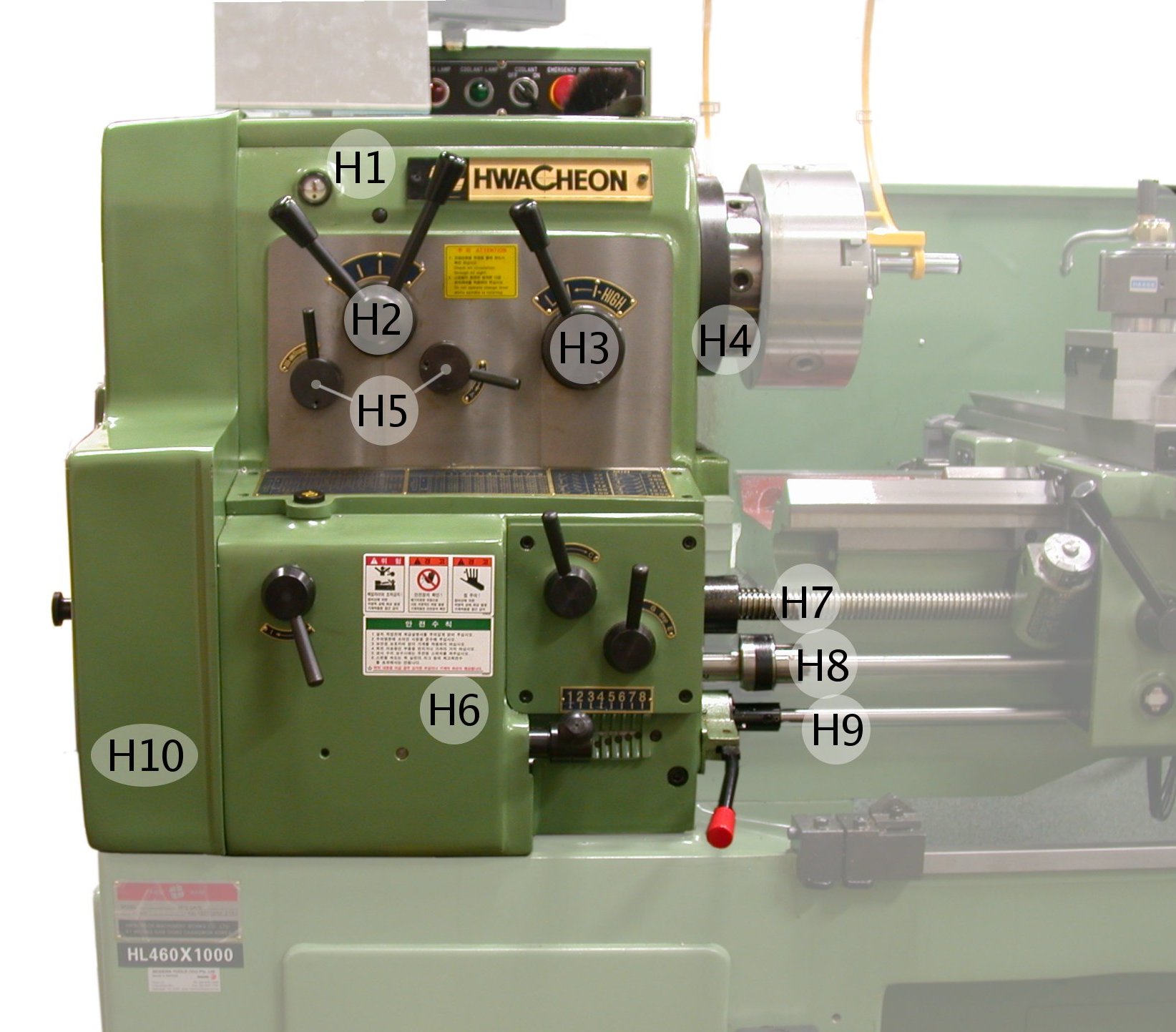
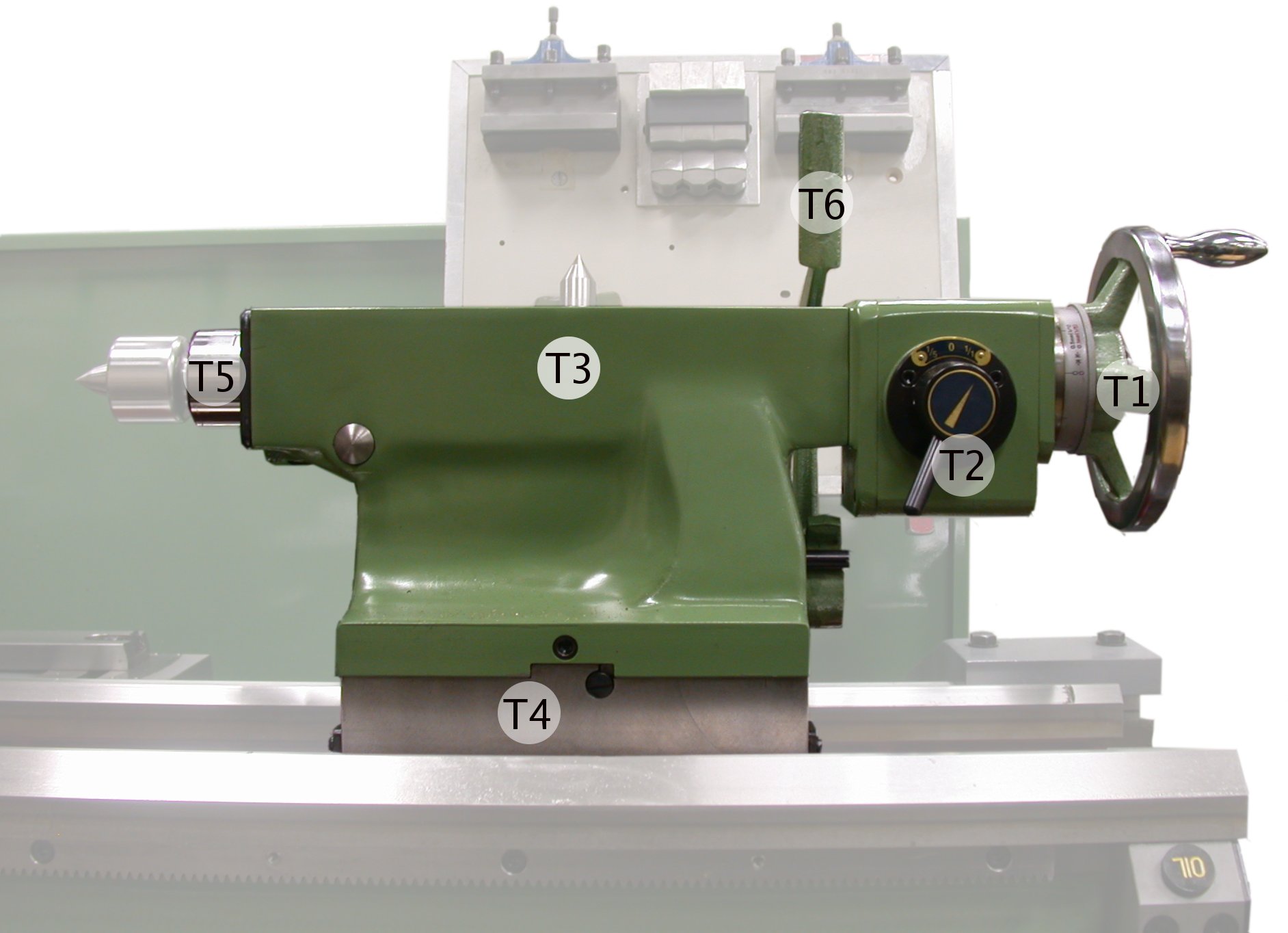

This is a great guide! I’m a woodturner and this will help me a lot.
Thanks for your feedback.
I liked some notes on this pdf
I’m glad it was helpful for you.
Thanks for the information 🧠🧠🙏
You’re most welcome.
I’m a beginner (as in NEVER used a Metal Lathe before!!) This information is So EASY to follow. If you’ve NEVER Operated or even Seen a Metal Lathe before you will be in EXCELLENT hands using this reference material. I’m so impressed!!! WELL DONE….
I purchased a Sherline 4000 series Benchtop Lathe combined with a many of the attachments & tools mentioned in this information.
Thank you so much for reading our article:)
Very good training information
Thank you 🙂